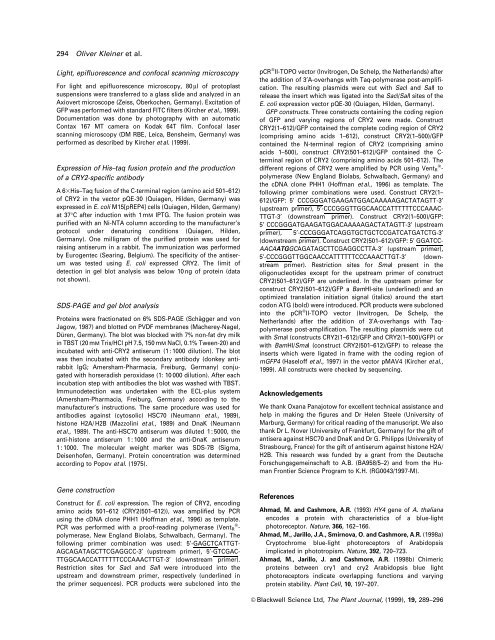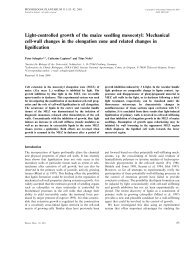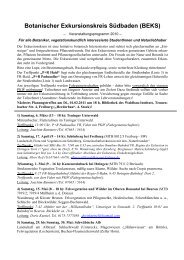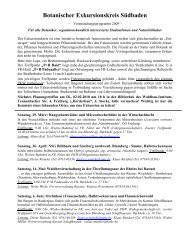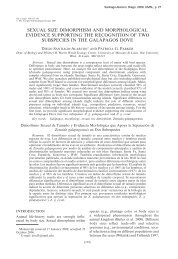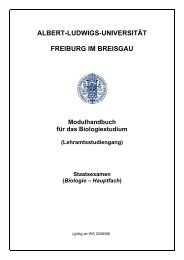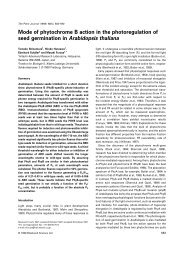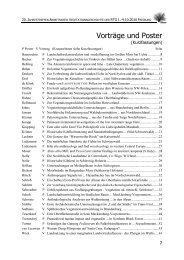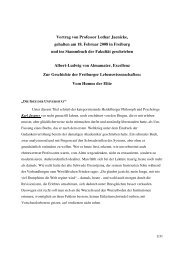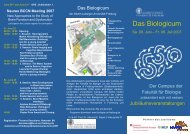Nuclear localization of the Arabidopsis blue light receptor ...
Nuclear localization of the Arabidopsis blue light receptor ...
Nuclear localization of the Arabidopsis blue light receptor ...
You also want an ePaper? Increase the reach of your titles
YUMPU automatically turns print PDFs into web optimized ePapers that Google loves.
294 Oliver Kleiner et al.<br />
Light, epi¯uorescence and confocal scanning microscopy<br />
For <strong>light</strong> and epi¯uorescence microscopy, 80 ml <strong>of</strong> protoplast<br />
suspensions were transferred to a glass slide and analyzed in an<br />
Axiovert microscope (Zeiss, Oberkochen, Germany). Excitation <strong>of</strong><br />
GFP was performed with standard FITC ®lters (Kircher et al., 1999).<br />
Documentation was done by photography with an automatic<br />
Contax 167 MT camera on Kodak 64T ®lm. Confocal laser<br />
scanning microscopy (DM RBE, Leica, Bensheim, Germany) was<br />
performed as described by Kircher et al. (1999).<br />
Expression <strong>of</strong> His±taq fusion protein and <strong>the</strong> production<br />
<strong>of</strong> a CRY2-speci®c antibody<br />
A63His±Taq fusion <strong>of</strong> <strong>the</strong> C-terminal region (amino acid 501±612)<br />
<strong>of</strong> CRY2 in <strong>the</strong> vector pQE-30 (Quiagen, Hilden, Germany) was<br />
expressed in E. coli M15[pREP4] cells (Quiagen, Hilden, Germany)<br />
at 37°C after induction with 1 mM IPTG. The fusion protein was<br />
puri®ed with an Ni-NTA column according to <strong>the</strong> manufacturer's<br />
protocol under denaturing conditions (Quiagen, Hilden,<br />
Germany). One milligram <strong>of</strong> <strong>the</strong> puri®ed protein was used for<br />
raising antiserum in a rabbit. The immunization was performed<br />
by Eurogentec (Searing, Belgium). The speci®city <strong>of</strong> <strong>the</strong> antiserum<br />
was tested using E. coli expressed CRY2. The limit <strong>of</strong><br />
detection in gel blot analysis was below 10 ng <strong>of</strong> protein (data<br />
not shown).<br />
SDS-PAGE and gel blot analysis<br />
Proteins were fractionated on 6% SDS-PAGE (SchaÈ gger and von<br />
Jagow, 1987) and blotted on PVDF membranes (Macherey-Nagel,<br />
DuÈ ren, Germany). The blot was blocked with 7% non-fat dry milk<br />
in TBST (20 mM Tris/HCl pH 7.5, 150 mM NaCl, 0.1% Tween-20) and<br />
incubated with anti-CRY2 antiserum (1 : 1000 dilution). The blot<br />
was <strong>the</strong>n incubated with <strong>the</strong> secondary antibody (donkey antirabbit<br />
IgG; Amersham-Pharmacia, Freiburg, Germany) conjugated<br />
with horseradish peroxidase (1: 10 000 dilution). After each<br />
incubation step with antibodies <strong>the</strong> blot was washed with TBST.<br />
Immunodetection was undertaken with <strong>the</strong> ECL-plus system<br />
(Amersham-Pharmacia, Freiburg, Germany) according to <strong>the</strong><br />
manufacturer's instructions. The same procedure was used for<br />
antibodies against (cytosolic) HSC70 (Neumann et al., 1989),<br />
histone H2A/ H2B (Mazzolini et al., 1989) and DnaK (Neumann<br />
et al., 1989). The anti-HSC70 antiserum was diluted 1 : 5000, <strong>the</strong><br />
anti-histone antiserum 1 : 1000 and <strong>the</strong> anti-DnaK antiserum<br />
1 : 1000. The molecular weight marker was SDS-7B (Sigma,<br />
Deisenh<strong>of</strong>en, Germany). Protein concentration was determined<br />
according to Popov et al. (1975).<br />
Gene construction<br />
Construct for E. coli expression. The region <strong>of</strong> CRY2, encoding<br />
amino acids 501±612 (CRY2(501±612)), was ampli®ed by PCR<br />
using <strong>the</strong> cDNA clone PHH1 (H<strong>of</strong>fman et al., 1996) as template.<br />
PCR was performed with a pro<strong>of</strong>-reading polymerase (Vent R q -<br />
polymerase, New England Biolabs, Schwalbach, Germany). The<br />
following primer combination was used: 5¢-GAGCTCATTGT-<br />
AGCAGATAGCTTCGAGGCC-3¢ (upstream primer), 5¢-GTCGAC-<br />
TTGGCAACCATTTTTTCCCAAACTTGT-3¢ (downstream primer).<br />
Restriction sites for SacI and SalI were introduced into <strong>the</strong><br />
upstream and downstream primer, respectively (underlined in<br />
<strong>the</strong> primer sequences). PCR products were subcloned into <strong>the</strong><br />
pCR q II-TOPO vector (Invitrogen, De Schelp, <strong>the</strong> Ne<strong>the</strong>rlands) after<br />
<strong>the</strong> addition <strong>of</strong> 3¢A-overhangs with Taq-polymerase post-ampli®cation.<br />
The resulting plasmids were cut with SacI and SalI to<br />
release <strong>the</strong> insert which was ligated into <strong>the</strong> SacI/SalI sites <strong>of</strong> <strong>the</strong><br />
E. coli expression vector pQE-30 (Quiagen, Hilden, Germany).<br />
GFP constructs. Three constructs containing <strong>the</strong> coding region<br />
<strong>of</strong> GFP and varying regions <strong>of</strong> CRY2 were made. Construct<br />
CRY2(1±612)/GFP contained <strong>the</strong> complete coding region <strong>of</strong> CRY2<br />
(comprising amino acids 1±612), construct CRY2(1±500)/GFP<br />
contained <strong>the</strong> N-terminal region <strong>of</strong> CRY2 (comprising amino<br />
acids 1±500), construct CRY2(501±612)/GFP contained <strong>the</strong> Cterminal<br />
region <strong>of</strong> CRY2 (comprising amino acids 501±612). The<br />
different regions <strong>of</strong> CRY2 were ampli®ed by PCR using VentR q -<br />
polymerase (New England Biolabs, Schwalbach, Germany) and<br />
<strong>the</strong> cDNA clone PHH1 (H<strong>of</strong>fman et al., 1996) as template. The<br />
following primer combinations were used. Construct CRY2(1±<br />
612)/GFP: 5¢ CCCGGGATGAAGATGGACAAAAAGACTATAGTT-3¢<br />
(upstream primer), 5¢-CCCGGGTTGGCAACCATTTTTTCCCAAAC-<br />
TTGT-3¢ (downstream primer). Construct CRY2(1±500)/GFP:<br />
5¢ CCCGGGATGAAGATGGACAAAAAGACTATAGTT-3¢ (upstream<br />
primer), 5¢-CCCGGGATCAGGTGCTGCTCCGATCATGATCTG-3¢<br />
(downstream primer). Construct CRY2(501±612)/GFP: 5¢ GGATCC-<br />
AACAATGGCAGATAGCTTCGAGGCCTTA-3¢ (upstream primer),<br />
5¢-CCCGGGTTGGCAACCATTTTTTCCCAAACTTGT-3¢ (downstream<br />
primer). Restriction sites for SmaI present in <strong>the</strong><br />
oligonucleotides except for <strong>the</strong> upstream primer <strong>of</strong> construct<br />
CRY2(501±612)/GFP are underlined. In <strong>the</strong> upstream primer for<br />
construct CRY2(501±612)/GFP a BamHI-site (underlined) and an<br />
optimized translation initiation signal (italics) around <strong>the</strong> start<br />
codon ATG (bold) were introduced. PCR products were subcloned<br />
into <strong>the</strong> pCR q II-TOPO vector (Invitrogen, De Schelp, <strong>the</strong><br />
Ne<strong>the</strong>rlands) after <strong>the</strong> addition <strong>of</strong> 3¢A-overhangs with Taqpolymerase<br />
post-ampli®cation. The resulting plasmids were cut<br />
with SmaI (constructs CRY2(1±612)/GFP and CRY2(1±500)/GFP) or<br />
with BamHI/SmaI (construct CRY2(501±612)/GFP) to release <strong>the</strong><br />
inserts which were ligated in frame with <strong>the</strong> coding region <strong>of</strong><br />
mGFP4 (Hasel<strong>of</strong>f et al., 1997) in <strong>the</strong> vector pMAV4 (Kircher et al.,<br />
1999). All constructs were checked by sequencing.<br />
Acknowledgements<br />
We thank Oxana Panajotow for excellent technical assistance and<br />
help in making <strong>the</strong> ®gures and Dr Helen Steele (University <strong>of</strong><br />
Marburg, Germany) for critical reading <strong>of</strong> <strong>the</strong> manuscript. We also<br />
thank Dr L. Nover (University <strong>of</strong> Frankfurt, Germany) for <strong>the</strong> gift <strong>of</strong><br />
antisera against HSC70 and DnaK and Dr G. Philipps (University <strong>of</strong><br />
Strasbourg, France) for <strong>the</strong> gift <strong>of</strong> antiserum against histone H2A/<br />
H2B. This research was funded by a grant from <strong>the</strong> Deutsche<br />
Forschungsgemeinschaft to A.B. (BA958/5±2) and from <strong>the</strong> Human<br />
Frontier Science Program to K.H. (RG0043/1997-M).<br />
References<br />
Ahmad, M. and Cashmore, A.R. (1993) HY4 gene <strong>of</strong> A. thaliana<br />
encodes a protein with characteristics <strong>of</strong> a <strong>blue</strong>-<strong>light</strong><br />
photo<strong>receptor</strong>. Nature, 366, 162±166.<br />
Ahmad, M., Jarillo, J.A., Smirnova, O. and Cashmore, A.R. (1998a)<br />
Cryptochrome <strong>blue</strong>-<strong>light</strong> photo<strong>receptor</strong>s <strong>of</strong> <strong>Arabidopsis</strong><br />
implicated in phototropism. Nature, 392, 720±723.<br />
Ahmad, M., Jarillo, J. and Cashmore, A.R. (1998b) Chimeric<br />
proteins between cry1 and cry2 <strong>Arabidopsis</strong> <strong>blue</strong> <strong>light</strong><br />
photo<strong>receptor</strong>s indicate overlapping functions and varying<br />
protein stability. Plant Cell, 10, 197±207.<br />
ã Blackwell Science Ltd, The Plant Journal, (1999), 19, 289±296


